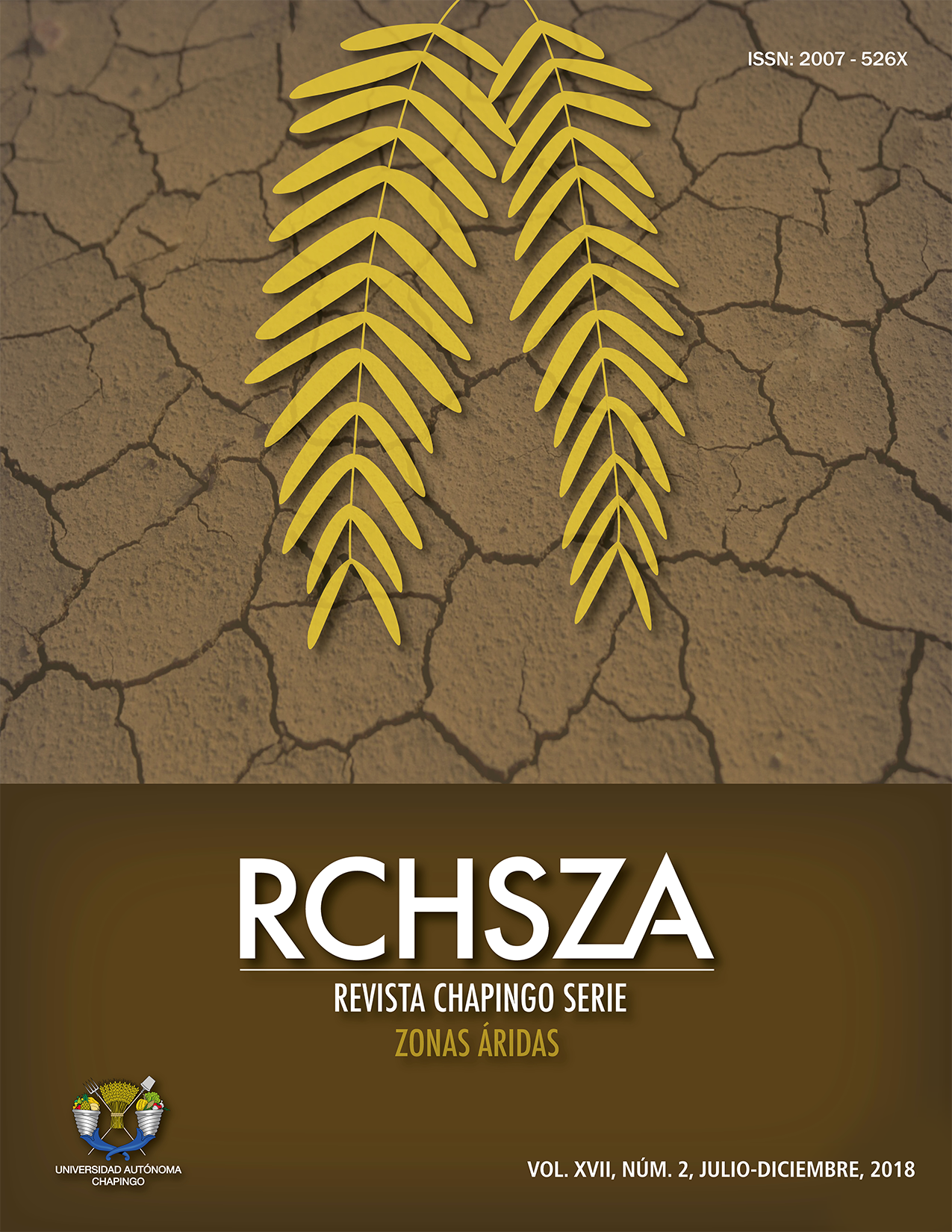Abstract
Pumpkin (Cucurbita sp) is used as human food in different regions of the world. The objective of this study was to evaluate water deficit tolerance in two pumpkin species by means of anatomical attributes. For this purpose, a randomized block experimental design was used in a split-plot arrangement with three replicates. Two soil moisture levels were managed in the large plots: Field Capacity (FC: range 21-26 %) and Permanent Wilting Point (PWP: range 15-20 %); two pumpkin species were distributed in the small plots: C. moschata and C. argyrosperma. Main stem length of C. argyrosperma plants under FC conditions was higher (P ≤ 0.05) than that of C. moschata plants at PWP level. The C. argyrosperma plants at PWP developed longer stems than those of C. moschata plants at FC and PWP. The variables plant cover and leaf area had an increasing exponential behavior regardless of the soil moisture condition. Results indicate that both species can be tolerant to water stress through the avoidance strategy
References
Andres, T. C. (2004). Diversity in tropical pumpkin (Cucurbita moschata): a review of intraspecific classifications. In: Progress in Cucurbit Genetics and Breeding Research. Proceedings of Cucurbitaceae 2004, the 8th EUCARPIA Meeting on Cucurbit Genetics and Breeding. A Lebeda, H S Paris (eds.). Olomouc, Czech Republic. p. 107-112.
Araus, J. L., Slafer, G. A., Reynolds, M. P., & Royo, C. (2002). Plant breeding and drought in C3 cereals: what should we breed for? Annals of Botany, 89(7), 925-940.
Comisión Nacional del Agua (CNA) (2006). Estadísticas del agua en México. México: Secretaría del Medio Ambiente y Recursos Naturales.
Comisión Nacional del Agua (CNA) (2001). Programa Hidráulico de Gran Visión 2001-2025. Gerencia Regional de las Cuencas Centrales del Norte. Torreón, Coahuila.
Córdoba-Rodríguez, D., Vargas-Hernández, J.J, López-Upton, J., & Muñoz-Orozco, A. (2011). Crecimiento de la raíz en plantas jóvenes de Pinus pinceana Gordon en respuesta a la humedad del suelo. Agrociencia, 45: 493-506.
Decker-Walters, D. S, Walters, T., Poluszny, & U., Kevan, P. (1990). Genealogy and gene f low among annual domesticated species of Cucurbita, Can. J. Bot. 68,782-789.
Decker-Walters, D. S, Staub, J., Chung, S., Nakata, E., & Quemada, H. (2002). Diversity in free-living populations of Cucurbita pepo (Cucurbitaceae) in North America, Plant Syst. Evol., 233, 183-197.
Farooq, M., Wahid, A., Kobayashi, N., Fujita, D., & Basra, S. M. A. (2009). Plant Drought Stress: Effects, Mechanisms and Management. In Sustainable Agriculture Netherlands: Springer. p. 153–188.
Hernández, S. B., Martínez, S. C. E., Gordillo, M. A. M., Castro, R. J., Gómez, A. A., Hernán y Lira, E., & Rodríguez, M. J. (2014) Potencial nutricional de la semilla de calabaza (Cucurbita pepo). In: Alimentos en México y su relación con la salud. Universidad Juárez del Estado de Durango.
Kavar, T., Maras, M., Kidric, M., Sustar-Vozlic, J., & Meglic, V. (2008). Identification of genes involved in the response of leaves of Phaseolus vulgaris to drought stress, Molecular Breeding. 21(2), 159-172.
Lebeda, A., Widrlechner, M., Staub, J., Ezura, H., Zalapa, J., & Kristová, E. (2007). Cucurbits (Cucurbitaceae; Cucumis spp., Cucurbita spp., Citrullus spp.) In: Genetic Resources, Chromosome Engineering, and Crop Improvement. Vol. 3. Vegetable Crops. R. J. Singh (ed). CRC Press. Boca Raton, FL, USA. p. 271-376.
Lira, R., Andres, T., & Nee, M. (1995). Estudios taxonómicos y ecogeográficos de las Cucurbitaceae latinoamericanas de importancia económica. Cucurbita, Sechium, Sicana yCyclanthera. In: Lira, R. (Ed.) International plant genetic resources institute, Rome, Italy. Chapter I. p. 1–115.
Mahajan, S., & Tuteja, N. (2005). Cold, salinity and drought stresses: an overview. Archives of Biochemistry and Biophysics, (444), 139-158.
Pedroza, S. A. (1995). El déficit hídrico en las plantas. Principios y técnicas de manejo. Universidad Autónoma Chapingo, Unidad Regional Universitaria de Zonas Áridas. 162 p.
Pedroza S. A., Trejo C. R, Chávez R. J. A., & Samaniego G. J. A. (2013). Tolerancia al estrés hídrico y fitosanitario mediante indicadores agronómicos y fisiológicos en diferentes variedades de frijol (Phaseolus vulgaris L.). Revista Mexicana de Fitopatología, 31 (2), 91-104.
Pedroza, S. A., & Berdejo, D. S. (2005). Efecto del acolchado plástico, fertilización nitrogenada y composta orgánica en el crecimiento y desarrollo de sábila Aloe barbadensis Miller, con riego por goteo presurizado. Revista Chapingo Serie Zonas Áridas 4: 1-7.
Pedroza, S. A., & Gómez, L. F. (2006). La Sábila. Propiedades, Manejo Agronómico, Proceso Agroindustrial y de Mercado. Universidad Autónoma Chapingo.
Pedroza-Sandoval A., Trejo-Calzada, R., Sánchez-Cohen I., Samaniego-Gaxiola J. A, & Yáñez-Chávez L. G. (2016). Evaluación de tres variedades de frijol pinto bajo riego y sequía en Durango, México. Revista Agronomía Mesoamericana 27(1):167-176. DOI: https://doi.org/10.15517/am.v27i1.21896
Rosales, S. R., Ramírez, V. P., Acosta, J. A., Castillo, G. F., & Nelly, J. D. (2002). Rendimiento de grano y tolerancia a la sequía del fríjol común en condiciones de campo. Agrociencia 34, 153-165.
SIAP (2017). Sistema de Información Agroalimentaria y Pesquera. Consultado en: https://www.gob.mx/siap/...programas/produccion-agricola-33119
Takahashi, S., Murata, N. (2008). How do environmental stresses accelerate photo-inhibition? Trends in Plant Science, 13, 178-182
Valadez, L. A. (1994). Producción de hortalizas. Ed. Trillas. México. 117 p.
Villanueva, V. C. (2007). Calabazas cultivadas. Identificación de especies, caracterización y descripción varietal. Universidad Autónoma Chapingo. Texcoco, Edo de México. 123 p.

This work is licensed under a Creative Commons Attribution-NonCommercial 4.0 International License.
Copyright (c) 2018 Revista Chapingo Serie Zonas Áridas




